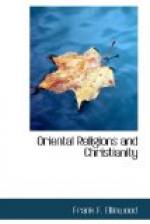It seemed scarcely possible that achievements so brilliant could have been the work of a mere unlettered Arab and his brave but unpretentious successors. The personnel of the prophet must be raised to an adequate proportion to such a history. Special requisition was made therefore for incidents. The devout fancy of the faithful was taxed for the picturesque and marvellous; and the system which Mohammed taught, and the very place in which he was born, must needs be raised to a supernatural dignity and importance. Accordingly, the history of the prophet was traced back to the creation of the world, when God was said to have imparted to a certain small portion of earthy dust a mysterious spark of light. When Adam was formed this particular luminous dust appeared in his forehead, and from him it passed in a direct line to Abraham. From Abraham it descended, not to Isaac, but to Ishmael; and this was the cause of Sarah’s jealousy and the secret of all Abraham’s domestic troubles. Of course, this bright spark of heavenly effulgence reappearing on the brow of each lineal progenitor, was designed ultimately for Mohammed, in whom it shone forth with tenfold brightness.
There is real historic evidence of the fact that the Vale of Mecca had for a long time been regarded as sacred ground. It was a sort of forest or extensive grove, a place for holding treaties among the tribes, a common ground of truce and a refuge from the avenger. It was also a place for holding annual fairs, for public harangues, and the competitive recitation of ballads and other poems. But all this, however creditable to the culture of the Arab tribes, was not sufficient for the purposes of Islam. The Kaaba, which had been a rude heathen temple, was raised to the dignity of a shrine of the true God, or rather it was restored, for it was said to have been built by Adam after a divine pattern. The story was this: At the time of the Fall, Adam and Eve had somehow become separated. Adam had wandered away to Ceylon, where a mountain peak still bears his name. But having been divinely summoned to Mecca to erect this first of earthly temples, he unexpectedly found Eve residing upon a hill near the city, and thenceforward the Valley of Mecca became their paradise regained. At the time of the Deluge the Kaaba was buried in mud, and for centuries afterward it was overgrown with trees.
When Hagar and her son Ishmael were driven out from the household of Abraham, they wandered by chance to this very spot, desolate and forsaken. While Hagar was diligently searching for water, more anxious to save the life of her son than her own, Ishmael, boy-like, sat poking the sand with his heel; when, behold, a spring of water bubbled up in his footprint. And this was none other than the sacred well Zemzem, whose brackish waters are still eagerly sought by every Moslem pilgrim. As Ishmael grew to manhood and established his home in the sacred city, Abraham was summoned to join him, that they together might rebuild the Kaaba. But in the succeeding generations apostacy again brought ruin upon the place, although the heathen Koreish still performed sacred rites there—especially that of sevenfold processions around the sacred stone. This blackened object, supposed to be an aerolite which fell ages ago, is still regarded as sacred, and the sevenfold circuits of Mohammedan pilgrims take the place of the ancient heathen rites.




